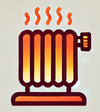Infrared heaters can positively impact your health by providing soothing warmth that improves circulation and alleviates muscle tension. Unlike traditional heaters, they warm objects and people directly, which can lead to a more comfortable living environment. But, it’s important to be aware of potential risks, such as skin irritation or dehydration with prolonged exposure.
Using infrared heaters responsibly can enhance your well-being, but moderation is key. By understanding both the benefits and the drawbacks, you can make informed choices that keep you warm and healthy.
Infrared Heater Health Effects Overview
Infrared heaters provide various health benefits through their unique warming technology. These heaters emit thermal waves that penetrate the skin and warm your body directly. This method improves circulation and can relieve muscle tension.
Immune System and Detoxification
Infrared heaters promote better immune function. Thermal waves increase blood flow, which boosts oxygen levels in your blood. Enhanced oxygen saturation helps in the regeneration of red blood cells. This process detoxifies vital organs. You may also notice improved production of white blood cells, supporting your body’s defenses.
Cardiovascular Health
Infrared heat positively impacts heart health. Research from NASA shows these heaters benefit the cardiovascular system. Studies published by the Mayo Clinic and the Journal of the American College of Cardiology highlight improvements in blood vessel function. This benefit is particularly useful for individuals with diabetes, high cholesterol, or those who smoke. Enhanced blood flow supports overall heart function.
Using infrared heaters responsibly maximizes benefits and minimizes risks. Consider your individual health needs and adjust usage accordingly. Enjoy the warmth while caring for your well-being.
Benefits of Infrared Heaters
Infrared heaters offer significant health benefits. They provide direct warmth, enhancing your comfort while supporting your well-being.
Pain Relief and Muscle Relaxation
Infrared heat penetrates deep into your muscles. It relaxes tight areas and alleviates pain. If you suffer from chronic muscle tension, infrared heaters can help ease discomfort. Studies show that this form of heat reduces soreness after exercise. You can use it post-workout to promote quick recovery for your muscles.
Improved Circulation
Infrared heaters promote better blood flow. The thermal waves expand your blood vessels, boosting circulation. Enhanced circulation brings more oxygen and nutrients to your cells. This increased blood flow helps with healing and detoxification, especially for those with circulation issues. You can experience improved energy levels as your bloodstream becomes more efficient.
Potential Risks Associated with Infrared Heaters
Infrared heaters offer benefits, but they also pose certain risks. You should be aware of these to use them safely.
Skin Irritation and Burns
Skin irritation can occur with prolonged exposure to infrared heat. The skin may become red or dry. You can avoid this by limiting your exposure time. Always maintain a safe distance from the heater. Burns are possible if the heater overheats or if you touch it directly. Check the surface temperature regularly to prevent accidents. If you notice any discomfort, turn off the heater immediately.
Respiratory Concerns
Some individuals may experience respiratory issues when using infrared heaters. Dust and allergens in the air can become more noticeable under dry heat. You should keep the area clean to minimize this risk. Proper ventilation can help reduce indoor air pressure and ensure airflow. Monitor for any signs of discomfort, such as coughing or wheezing, while using the heater. If respiratory problems persist, seeking medical advice is advisable.
Recommendations for Safe Use
Using infrared heaters correctly promotes health benefits while minimizing risks. Follow these recommendations for safe and effective use.
Proper Placement and Distance
Position your infrared heater at least three feet away from any objects. This distance prevents overheating and reduces the risk of burns. Place the heater in a well-ventilated area. Avoid placing it near flammable materials. Direct the heat towards the area you intend to warm for optimal results. Ensure that you sit or lie at a safe distance, allowing the warmth to reach you effectively without causing discomfort.
Duration of Use
Limit your exposure time to around 20 to 30 minutes per session. This helps prevent skin irritation or burns from prolonged heat exposure. Take breaks between sessions, allowing your body to cool down. Monitor your comfort level during use; adjust as needed. If you notice any signs of discomfort, discontinue use immediately. Regularly assess your needs, especially if you have health conditions that might be affected.
Conclusion
Using infrared heaters can offer significant health benefits when utilized correctly. They provide soothing warmth that can enhance circulation and promote muscle recovery. But it’s crucial to be mindful of potential risks like skin irritation and respiratory issues.
By following safety guidelines such as maintaining a safe distance and limiting exposure time, you can enjoy the advantages of infrared heating while minimizing drawbacks. Always consider your personal health needs and consult with a healthcare professional if you have any concerns. With responsible use, infrared heaters can be a valuable tool for improving your overall well-being.








